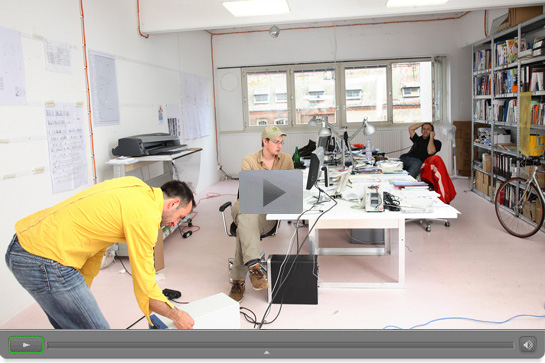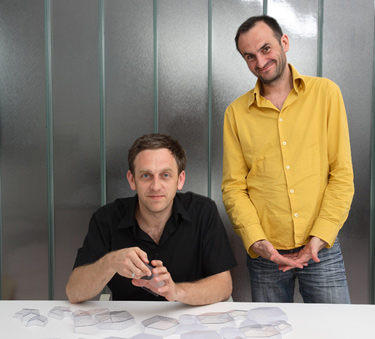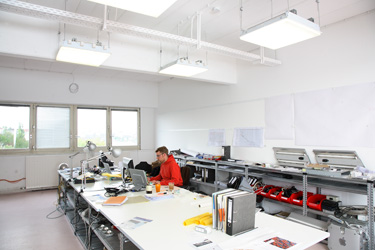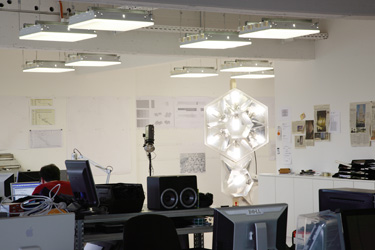
Profil


For the brothers Jan and Tim Edler, one thing is certain: Buildings communicate with their surroundings. They prove this by means of totally different pieces of work, which they themselves refer to as architecture tuning. And the fact that they are in the right with this outlook is proven by several successful projects the studio has completed since it designed the media facade on Kunsthaus Graz; ever since, the Berlin-based architects have been hired as media designers on building projects throughout the world. And each time they get a little closer to their personal vision of the creation of a special architectural statement.
It all began in Berlin in the 1990s, where, in run-down factories, old apartments, and cellars young creative minds created an experimental ground for turning their dreams and ideas into reality. Back then, together with other artists and designers, the two architecture students Jan and Tim Edler set up the Berlin platform “kunst und technik” (art and technology). The range of works spanned proposals for turning a side arm of the River Spree into a swimming pool, and multi-media installations, to studies of non-verbal communication with the help of digital technology. The projects were spiced up with events and exhibitions, which quickly became a point of attraction for the Berlin party scene. Following the demolition of the building housing their studio overlooking Monbijou Park in the Mitte district of Berlin, in 2000 the Edler brothers moved into their first laboratory for art, architecture, and technology, called ‘realities : united’ in the “Ebbinghaus” building on Leipziger Strasse. They have since moved offices, though the name has remained the same.
What Jan and Tim Edler are most certainly not lacking are approaches of their own. Yet in order to push these through they were for years initially forced to initiate projects without clients. Even though they had primarily begun with the design of media interventions in space, they subsequently made a name for themselves first and foremost as façade designers and media artists. not least of all on account of their spectacular concept for Kunsthaus Graz, which was completed between 2001 and 2003. For this they were initially only commissioned with the design of the building’s media equipment, but were ultimately able to win over the clients to a daring façade design. Beneath the acrylic skin of the “Friendly Alien” designed by Sir Peter Cook and Colin Fournier the made 930 fluorescent lamps into a low-res screen, which communicates with the surroundings by means of roughly structured picture sequences, films and text. Here, as in all their work, they were primarily interested in the range of opportunities to create a message.
Although even today there is still a lot of convincing work to be done where lots of projects are concerned, Jan and Tim Edler are still increasingly successful and very happy with their work. In doing so they pursue step by step the development and definition of what architects and developers still neglect, which frequently results in unattractive results. Jan and Tim Edler are not basically concerned about lighting up buildings as modern media experts. Rather, with their projects, which still embrace totally different areas of architecture, they attempt to create statements. To this end the tools they use are just as much digitally moving as static, old media. So it is a studio that is designing the future, even though it doesn’t always look like “Bladerunner”.
In 2006 for example realities : united developed the Museum X project in Mönchengladbach, which involved classic media only. The aim was, in the year the municipal museum was closed for renovation purposes, to erect a symbol in he city that would ensure the museum itself would not be forgotten. To this end sections of an empty building close to downtown were covered in fabric portraying the museum. On the inside visitors were greeted by a lady in the foyer who was, however, not selling tickets for an exhibition, as the entrance area marked the end of the installation.
Jan and Tim Edler are currently working on three projects, for which the architects responsible hired them as experts for the media design. In the case of two buildings in Singapore the client is eager to create a sort of artistic media design on the façade. For another project in Cordoba realities : united is far more heavily involve in the design process. Together with Nieto Sobejano Architects in Madrid they are designing a media façade that has neither structure nor even concentration, playing instead with the possibilities visual perception presents.
For our interview we visited realities : united in the trendy new slightly run-down area at Schlesisches Tor in the Kreuzberg district of Berlin. This is also a temporary home, as in the near future their former office building at 47-49 Falckensteinstrasse, which currently houses a club, a few galleries, an architecture studio and various other offices, is to be completely renovated and converted into up-market lofts. The office is on the top floor and affords the most amazing view of Kreuzberg, across the U1 underground line and down the River Spree as far as the TV tower in the Mitte district. In a relaxed working atmosphere in the open-plan office we spoke to Tim Edler about the team’s new projects, media facades as a symptom of weak architecture, and the desire to create messages by means of architectural interventions.














































